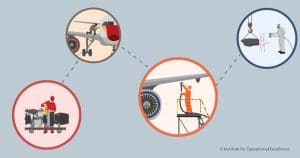A smaller interval means there’s less chance for things to go wrong. That’s just one of the reasons smaller is better.
Manufacturing
Transformation in MRO: Process, Culture, Leadership
Take a deep dive into process, culture and leadership to learn why this three-pronged approach is essential for achieving transformation in MRO operations.
Transformation in MRO: Process, Culture, LeadershipRead More
How to Optimize Manufacturing Flow During Irregular Seasonal Demand
Learn how to turn seasonal unpredictability into opportunity with mixed model flow.
How to Optimize Manufacturing Flow During Irregular Seasonal DemandRead More
How Do You See Flow to the Customer? What are Some Examples?
From our member-submitted questions, OpEx expert Kevin Duggan reveals the importance of creating a value stream to see the flow of value, the key elements necessary to accomplish this and real-world examples of how some companies are using visuals to see the flow.
How Do You See Flow to the Customer? What are Some Examples?Read More
Product Family Matrix: The First Step in Creating Flow Through Shared Resources
Identifying which processes are shared resources that produce components for different product families is easier than you think. Learn about the tool that can help you make the determination.
Product Family Matrix: The First Step in Creating Flow Through Shared ResourcesRead More
Changes in Customer Demand? No Problem.
Learn the top two ways to address the common challenge of changing customer demand in environments with high product mix. These tips will give you the flexibility you – and your customers – need.
When Creating Flow, What is Normal?
Knowing how to visualize normal versus abnormal flow can be challenging. In this article, learn how to identify flow that is becoming abnormal in continuous manufacturing operations, financial offices and startups.
Creating Flow in High-Variety Environments
Adhesives and sealants manufacturers face unique
challenges compared to other industries when undergoing lean or continuous improvement initiatives, including chemical reactions, vessels, batch sizes, curing times, and many more. None of these issues are addressed by the lean techniques that grew from the automotive industry. So how can this industry create flow in its high-variety, complex environments? To start, operations must take a different approach to continuous improvement itself.
Practical Tips for Mapping Value Streams in MRO Operations
Value stream mapping in an MRO isn’t straightforward due to the high amount of variation that exists. Learn 8 steps to create an accurate design for the most value.
Practical Tips for Mapping Value Streams in MRO OperationsRead More
FAQs on Designing Product Families for Mixed Model Production
Understand common obstacles to creating product families for mixed model production and how to overcome them.
FAQs on Designing Product Families for Mixed Model ProductionRead More
How to Make Flow Visual
Achieving Operational Excellence is dependent on every employee being able to “see” how the processes are connected. Learn how to implement a robust system of visuals to drive business growth.
Managing Intervals for OpEx
Learn how setting a destination of Operational Excellence produces significant gains in both operational and financial results in months, rather than an “endless journey” of continuous improvement.
The Evolution of Lean to OpEx: Studies in Success
Kevin Duggan, of Duggan Associates, explores how lean has transformed over the years and spawned its shoot-offs. Are they greater than their predecessor or do they lend themselves to the improvement of all?
Assembling a Product Family Matrix with 500 Assemblies
This Q&A article discusses how to sort 500 assemblies into a product matrix.
Assembling a Product Family Matrix with 500 AssembliesRead More
The Role of Flow for Operational Excellence
This Q&A style article helps explain the difference between traditional lean thinking and more progressive lean thinking that drives Operational Excellence.















